
The Tank Destroyer Board archives contain a proposal, dated April of 1942, for a light tank destroyer battalion, known as Grenadiers. Obviously this battalion never made it to fielding, but as a little-known example of thinking near the beginning of TD branch’s existence, this should prove of some interest.
The following memorandum was addressed to the President, Tank Destroyer Board, Temple, TX. My first observation is that unlike LT Bate, LTC Negrotto, IN, the author of the following, didn’t go straight to the General Officer Commanding. In fact, he went only one pay grade up. The other is that his proposal, though perhaps a little out of the box to us now, is by no means as far-fetched as the under-water M18.
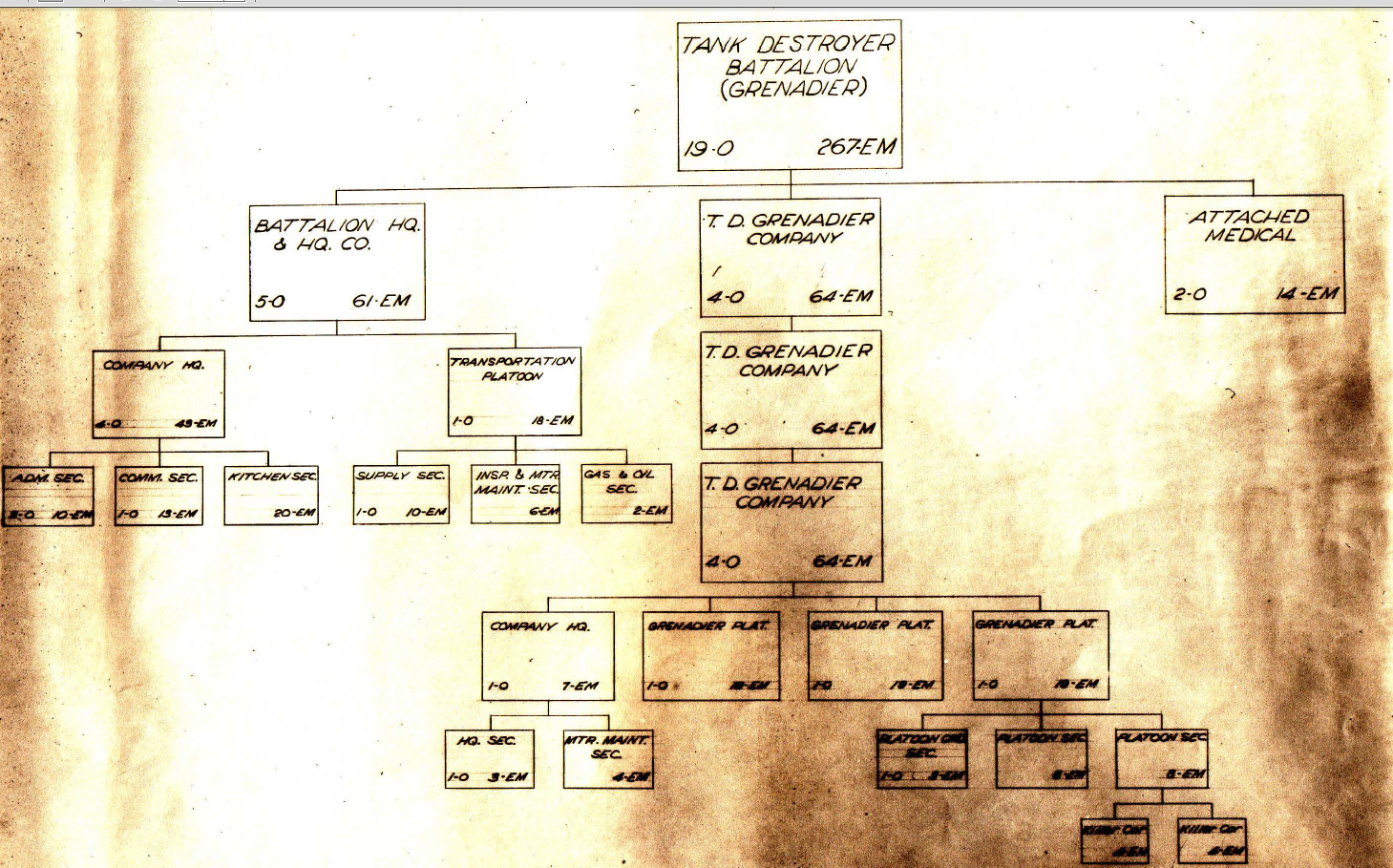
Subject: Provisional Tank Destroyer Battalion (Grenadier).
PROBLEM PRESENTED.
1. Reference my memorandum of March 4, 1942, subject same as above, organizational details (Tabs A, B, and C), and precis of tactical doctrine (Tab D) for a provisional battalion of tank destroyer grenadiers have been prepared for consideration by the Commanding General of the Tank Destroyer Command.
2. At the outset of this paper it is desired to emphasize the following points:
a. This is a proposed test project.
b. The proposed battalion is not intended to supplant any organization now in the Tank Destroyer Command.
c. All equipment required is now in mass production.
d. Its tactical mission differs from that of the heavy battalion.
e. Its surprise appearance on the battle field will have a tremendous demoralizing effect on the enemy. -
II. DISCUSSION.
3. The present tank destroyer battalion as now organized contains, to a lesser degree, all of the weapons in the proposed organization. The principal difference in the two lies in the tactical mission of each. The machine guns and grenades allotted to the various units of the heavy battalion are for use when the primary weapons are out of action. The primary weapon of' the proposed organization is the grenade, the secondary weapons are the .50 caliber machine gun and the .30 caliber rifle. In this connection it must be remembered that the grenade also is extremely effective against personnel in the open.The grenadier battalion with its own means and weapons is organized to find tanks and destroy them. The means of destruction is with the element which finds the hostile tanks. It is preeminently suited for jungle warfare,street fighting and for driving tanks and other mechanized forces from wooded areas, whereas the present battalion as now organized is not suited for this type warfare. In the initial stages of an operation it provides an excellent-means for developing the situation, or of clarifying an obscuresituation.
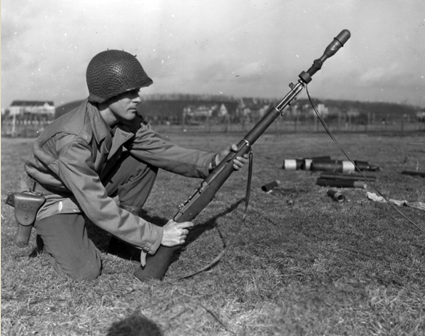
Grenade, Rifle, Anti-Tank, M9A1
4. The proposed battalion is organized as a “Mosquito Fleet of the Tank Killers" to prowl aggressively the battlefield within its zone of actionand for distant reconnaissance. Its mission in general is:
a. To assume the role of the heavy battalion in jungle warfare street fighting and in destroying tanks and mechanized units in wooded areas.
b. To lay in ambush athwart the axis of the tank attack and smash the individual tanks as they come within range.
c. To capture critical gun positions and hold them for the guns of the heavy tank destroyer battalion.
d. For night operation in locating and destroying enemy tank rendezvous, fueling stations and forward supply installations. The speed and comparative silence with which “killer cars” operate make this battalion especially suitable for this type of operation.
e. To exploit the successes of the heavy .battalion or armored divisions by mopping up remnants of tank or mechanized resistance.
f. To act as a fast, hard hitting reserve.
g. In case the hostile tank attack affects a break through to be used as a "mosquito fleet of killers" to literally swarm around -the hostile tanks and destroy them
h. To be used on independent distant reconnaissance missions in which combat may be expected. Its speed, fire power, training and means of concealment, gives it-a wide scope of action on missions of this character.
i. Close-in reconnaissance missions.
j. To protect the front and flanks of columns on the march or in a bivouac area.
k. On a wide front to supplement the ground warning service.
l. "Tank hunting" in obscure situations or in isolated terrain, or terrain inaccessible to the heavy units.
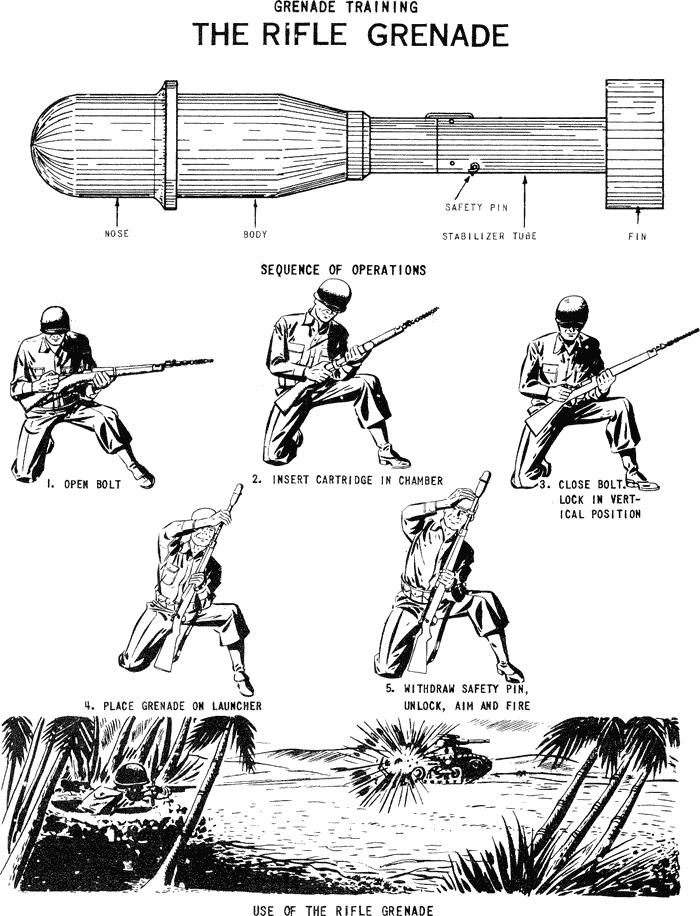
5. The unit of fire is the "killer car". The "killer car" is a ¼ ton 4x4 truck without armor -(Tab E) or the 3/4 ton 6x6 Willys (Tab F) with armor over the engine and the drivers compartment and a gun shield. Each car carries a caliber .50 machine gun on a low pedestal for all-around fire. The crew consists of four men (one driver and .assistant machine gun grenadier, one machine gun grenadier and two rifle grenadiers. All are trained in the tactical use of the machine gun and the rifle). It deploys for action with two rifle grenadiers to the front and flanks of the car (Tab G). These are supported by machine gun fire (grenade or ball ammunition as the situation dictates) delivered from the car or all four men may deploy as rifle grenadiers. Its combat is characterized by bold and independent action. · It demands a high order of individual initiative, courage and aggressiveness. Each unit as well as the individual is trained to attack whenever in doubt.

6. The organization is small, compact and self-contained. It is extremely mobile and has tremendous short range destructive fire in its grenades and medium range fire power in its weapons. It comprises a total of 19 officers and 267 enlisted men, or one-half the number of officers and less than one-third of the enlisted men in the present tank destroyerbattalion. The initial cost of one battalion and the cost of maintenance is negligible in comparison with the heavy tank destroyer battalion, while its destructive power, except for long ranges, is equal to or greaterthan that of the heavy battalion. Its tonnage is only 98 tons of rolling stock as compared with 1,150 tons in the heavy battalion. One .50 caliber grenade weighs 2-3/4 pounds as compared with 37 pounds for one round for the 3 inch gun. Tonnage is a vital consideration in overseas shipment due to the shortage of bottoms. Since this organization is especially adaptable to the type of warfare in the far Pacific theater of operations it can be immediately made use of and tested in battle. '
7. In the focus-of-power grenade we have the greatest tank destroying force yet devised. The problem is to put that power on the hostile tanks. This is accomplished in the proposed organization.
8 . For the advantages and disadvantages of the proposed battalion see Tab H.
9. The value of the grenadier battalion can best be determined by means of a series of tactical problems or controlled manuevers. The purpose of these problems will be to determine:
a. The soundness of the tactical doctrine outlined in Tab D,
b. The tactical efficacy of the proposed organization in stopping or interfering with the forward advance of hostile tanks,
c. Its value in tank hunting tactics,
d. Changes, if any, in the provisional organization.
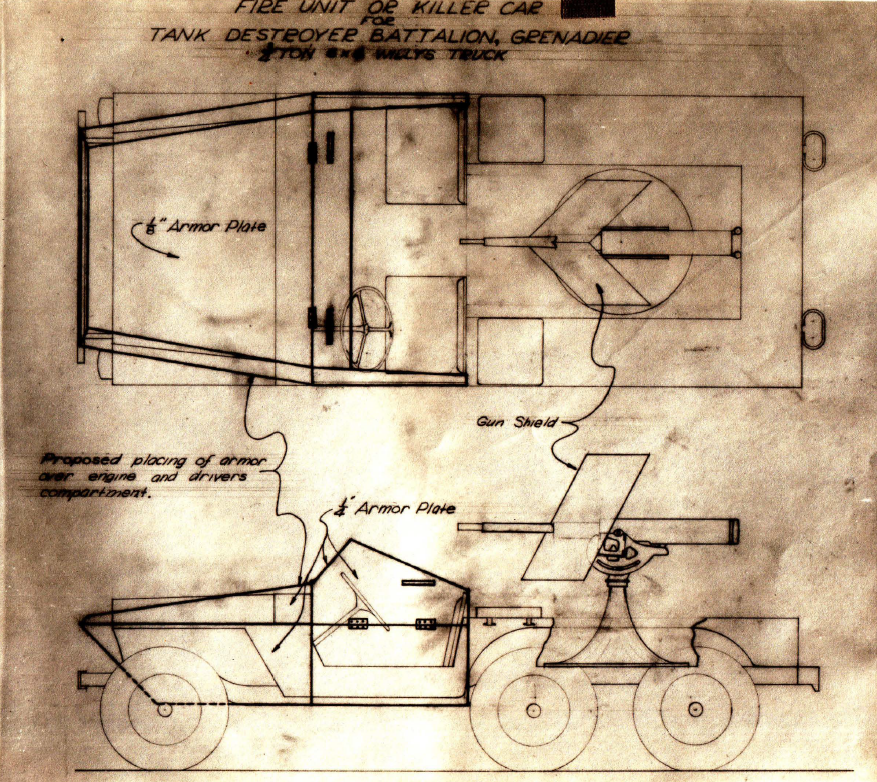
III Action Recommended:
10. That action beinitiated to organize a provisional battalion of grenadiers inaccordance with Tabs A,.B and C· for extended service test. Draft of' letter initiating this action is contained in Tab I
S. H. Negrotto
Lt Colonel, Infantry
PRECIS OF TACTICAL DOCTRINE FOR TANK DESTROYER BATTA.LION, GRENADIER
I. CHARACTERISTICS
1. The grenadier battalion is intended to perform those missions which are net suited to the heavy tank destroyer battalion. It combines tremendous close-in fire power with great speed and maneuverability. Its strength lies in its surprise action and its ability to operate over terrain inaccessible to or denied heavy weapons· and larger vehicles. It is primarily concerned with finding and destroying enemy tanks and mechanized units. It is especially adaptable for night operations, jungle warfare, street fighting, combat in woods, and for surprise action and distant reconnaissance. The main striking force is the grenade, therefore the range limit of its primary weapon is 400 yards, yet in its machine guns and rifles it has effective fire power against light tanks and mechanized units .at ranges up to 1500 yards. The skillful use of terrain is a decisive factor in its successful employment.
II. MISSION
2. The battalion will normally fight within the framework of the division or other units to which it is attached. It is organized to carry out independent antitank operations in which case .it may or may not be reinforced by motorized infantry or cavalry. Its mission is:
a. To assume the role of the heavy battalion in jungle warfare, street fighting and in the destruction of tanks and mechanized units in wooded areas.
b. To lay in ambush athwart the known axis of the tank attack and smash individual tanks as they come within range.
c. To capture critical terrain features for the guns of the heavy battalion and deny them to the enemy.
d. For night operation in locating and destroying enemy tank rendezvous, fueling stations and forward supply installations. The speed and comparative silence with which "killer cars" operate make this battalion especially suitable for this type of operation.
e. To exploit the successes of the heavy battalion or armored forces by mopping up remnants of tank or mechanized resistance.
f. To act as a fast, hard hitting reserve.
g,.In case the hostile tank attack affects a break through to be used as a "Mosquito fleet of killers" to literally swarm around the hostile tanks and destroy them one by one.
h. To be used on independent distant reconnaissance missions in which combat may be expected. Its speed, fire power, training and means of concealment gives it a wide scope of action on missions of this character.
i. For close-in reconnaissance missions.
j. To protect the front and flanks of columns on the march or in bivouac areas.
k. On a wide front to supplement the ground warning and reconnaissance service of the heavy battalion.
l. For tank "stalking and destruction" in obscure situations or in isolated terrain or terrain inaccessible to vehicles and guns of the heavy battalion.
III. DEPLOYMENT
3. The great speed and maneuverability of the battalion permits it to move practically anywhere ·on the battlefield. where a reasonable amount of cover or concealed routes of approach are available, and the relative silence of its vehicles when running permits it to approach, undetected, to within close range of the enemy objective.·
a. The battalion normally deploys with two companies ·in the assault echelon and one in reserve with the headquarters remaining with the reserve.
b. The company normally deploys with two platoons in the assault and one in support.
c. The platoon deploys with both sections in the assault.
d. The unit of fire is the "killer car". It deploys for action with two rifle grenadiers to the front and flanks of the car. These are supported by machine gun fire (grenade or ball ammunition as the situation dictates) delivered from the car or all four men deploy as rifle grenadiers. All elements take advantage of cover and concealment.
IV. PERSONNEL AND TRAINING:
4. In combat the battalion is characterized by bold and independent action. It demands a high order of individual initiative, courage and aggressiveness. Each unit as well as the individual is trained to attack whenever in doubt. · Methods of scouting and patrolling and skill in the use of its weapons form the basis of training for the battalion.
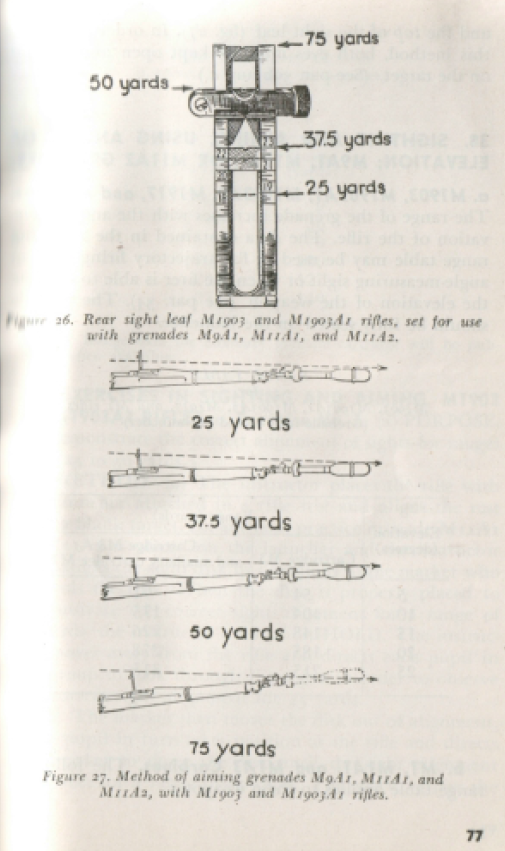
Page from FM 23-30 showing aiming technique.
RECONNAISSANCE
5. The great speed and wide ranges over which the hostile armored forces operate places an unusually heavy burden on all echelons of command and particularly on the antitank elements. Timely warning to the tank destroyer battalion to meet an unexpected thrust is of the greatest importance. While the tank destroyer battalion will act initially on information furnished from the higher headquarters it nevertheless is responsible for gathering its own information and for providing its own security. The grenadier tank destroyer battalion must be indoctrinated with the necessity of acting aggressively and on its own initiative in a changed or new or unseen situation.
6. It may be charged with a wide range of reconnaissance missions such as watching over railways, and roads, and of assisting in the placing of antitank obstacles. In all of these operations it is responsible for its own security and for transmitting information of vital importance to the next higher command.
7. It must be prepared and trained in cooperation with ground and air reconnaissance am in the transmission of important reports.
VI. IN ATTACK
8. In any tank attack the enemy antitank offense must be neutralized. To accomplishthis the elements of the antitank defense will be subjected to attacks from enemy tanks, the air, and motorized or foot infantry. To meet these attacks the grenadier battalion must be taught to attack aggressively at every opportunity.
VII. IN DEFENSE
9. In the defense the grenadier tank destroyer battalion is trained to deploy across the axis of approach of the hostile tank attack and wait in ambush. As the hostile tanks approaches within range they will be attacked and destroyed. Use of concealment and cover is essential.
10. The battalion likewise is trained to cut its way out of an encirclement should it be completely surrounded by enemy forces.
VIII. PURSUIT
11. In pursuit the grenadier battalion has a very limited field of action and should not be used in operations of this kind.
IX. WITHDRAWALS
12. In withdrawals the grenadier battalion will be charged with stopping the forward advance of hostile tanks and light mechanized forces.
X. SPECIAL OPERATIONS
13. In special operations the grenadier battalion has its greatest scope of action, such as jungle warfare, night operations, street fighting, combat in woods, as an advance element in a river crossing and for penetrating terrain which is inaccessible to the heavy tank destroyer units.
XI. RADIO COMMUNICATIONS
14. Radio communications are maintained by the battalion with higher echelons by means of one SCR-506 radio within the battalion headquarters. The battalion maintains contact with the companies by the use of SCR-508 radio. Companies maintain contact with the platoon through the SCR-510 radio. The attached medical detachment of the battalion is equipped with the SCR-510 as is the transportation platoon of the battalion headquarters and headquarters company. The commanding officer of the battalion headquarters company has available another SCR 506 radio for communication throughout the battalion and with attached aerial observation. This requires a total of four SCR-506 radios, one SCR-508, and thirteen SCR-510 radio sets for the battalion.
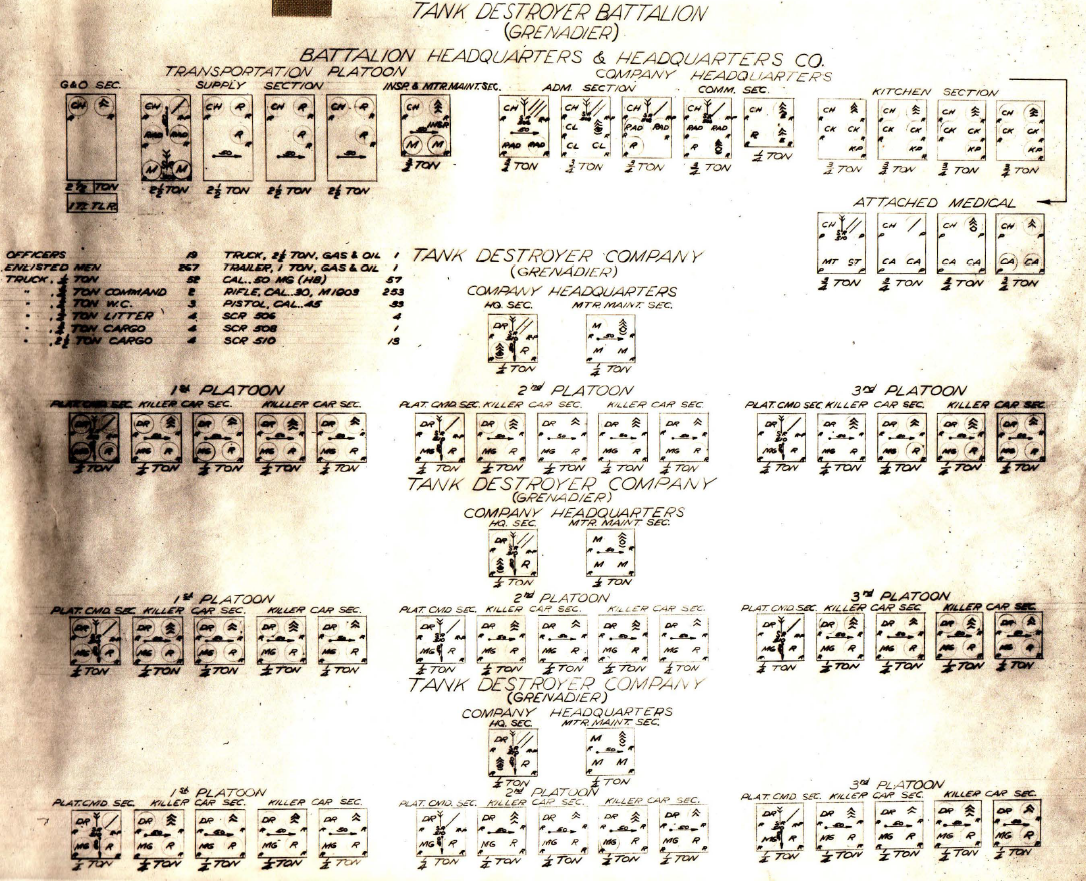
PROVISIONAL TANK DESTROYER BATTALION
(Grenadier)
ADVANTAGES AND DISADVANTAGES OF PROPOSED ORGANIZATION
ADVANTAGES:
1. Simplicity of organization.
2. Minimum of training time and' simplified training.
3. More adaptable for surprise operations than any other ground organization.
4. Tonnage of rolling equipment for overseas shipment is only 98 tons as compared with 1150 tons in the heavy tank destroyer battalion.
5. Tremendous fire power. As well as close range grenade fire power there is medium range .50 cal. MG and . 30 cal. rifle fire
6. Ample antiaircraft fire within the battalions, for defense against low-flying airoraft. All weapons have a dual mission and gunners are trained to .fire on aerial as well as ground targets. Ground targets are primary.
7. Ease and rapidity with which this battalion can disperse or·concentrate.
8. Ease and rapidity with which it can effect concealment or move to available cover.
9. Ease and rapidity of deployment. Each fire unit (killer car) is trained to act independently as well as collectively.
10. Small initial cost of equipment.
11. Simplified supply and field maintenance.
12. All equipment in the battalion is now in mass production.
13. Activation of new units rapid and simple.
14. Minimum of technical training required. All men coming from replacement-training centers will have received the requisite technical training .
15. The equipment of this organization is standard in other organizations, therefore its transfer or conversion to other units or vice versa is simple.
16. It occupies a small bivouac area. Each vehicle and its crew is independent for tactical operations, defense against aircraft, and in messing, and therefore is in readiness to move from bivouac to combatin a minimum of time.
17. The organization and equipment as well as the primary and secondary weapons are preminently suited for jungle warfare, street fighting, and for clearing wooded areas of hostile tanks or other mechanized units.
18. No rail shipment for long overland travel required.
19. It provides the best single means of hunting, finding and destroying tanks.
20. When deployed it presents a very small and unprofitable target from the air.
21. Great mobility and speed over roads and across country.
22. It utilizes a minimum amount of rubber, rubber being a critical item in the organization of new units.
23. Local .Protection is inherent in the organization and weapons.
24. It has a wide and varied scope of action for reconnaissance missions.
25. Suited for surprise night operations where speed and comparative silence of running vehicles are essential.
26. The weight of one machine gun grenade is· 2 ¾ pounds as compared with 37 pounds for the 3” gun.
DISADVANTAGES:
1. It lacks long range fire power.
2. Like all other organizations it is vulnerable to infantry attacks.
3. Its scope of action in desert or prairie warfare is limited
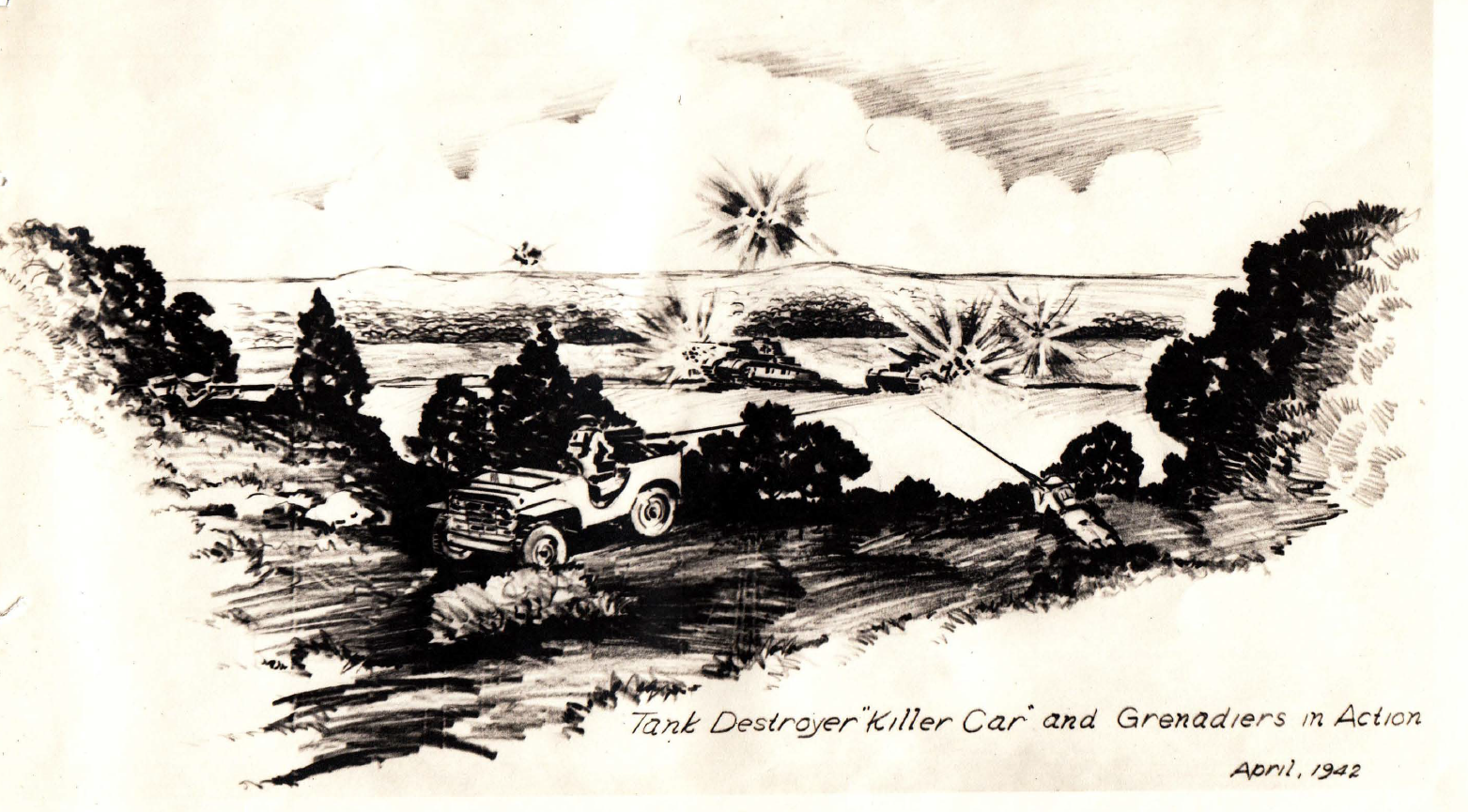
Now, we may laugh a little bit now at the concept of dealing with German tanks with a swarm of jeep-mounted troops armed with AT rifle grenades, but in fairness to the man, the idea was not entirely without merit, especially in restricted terrain. On the other hand, we're still talking about some 300 men, one and a half rifle companies, whose job is not to take and hold ground. It seems highly likely that if such an organisation were actually to be fielded, that they would immediately be given cavalry jobs, not tank destroyer jobs. And one probably would also get involved in internecine politics about if they truly are TD soldiers or Infantry soldiers. (Bear in mind, the Colonel writing this up was an infantryman). Further, an infantry company can probably do as good a job: The grenadier TD battalion would almost certainly require the use of covering infantry given the ranges they'd be operating at, and if you havd infantry that close, why not use their own AT rifles to take care of the tanks anyway?
There were a number of attemps made to create Tank Destroyer vehicles based around the Willys 4x4 and 6x6 vehicles mounting the 37mm gun, which one can argue is no better and no worse than lads armed with rifle grenades. It depended very much on range and individual grenadier accuracy. The 4x4 shown below is the 37mm GMC T2 (Modified), the 6x6 the 37mm GMC T14.
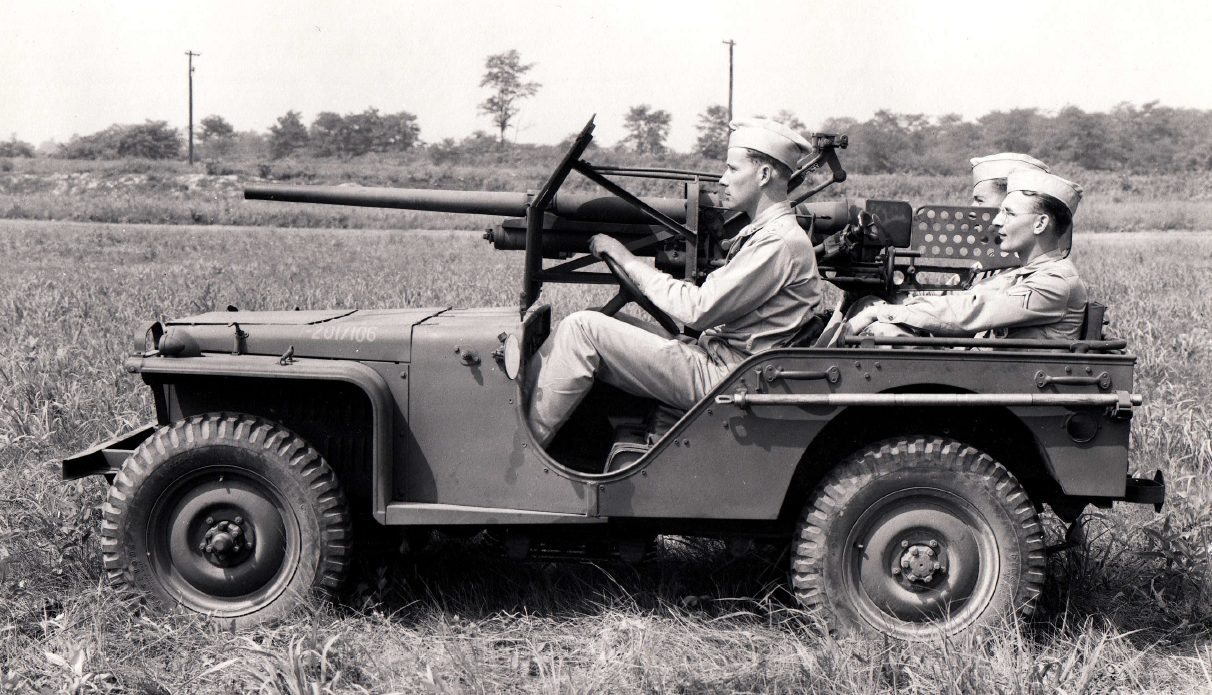
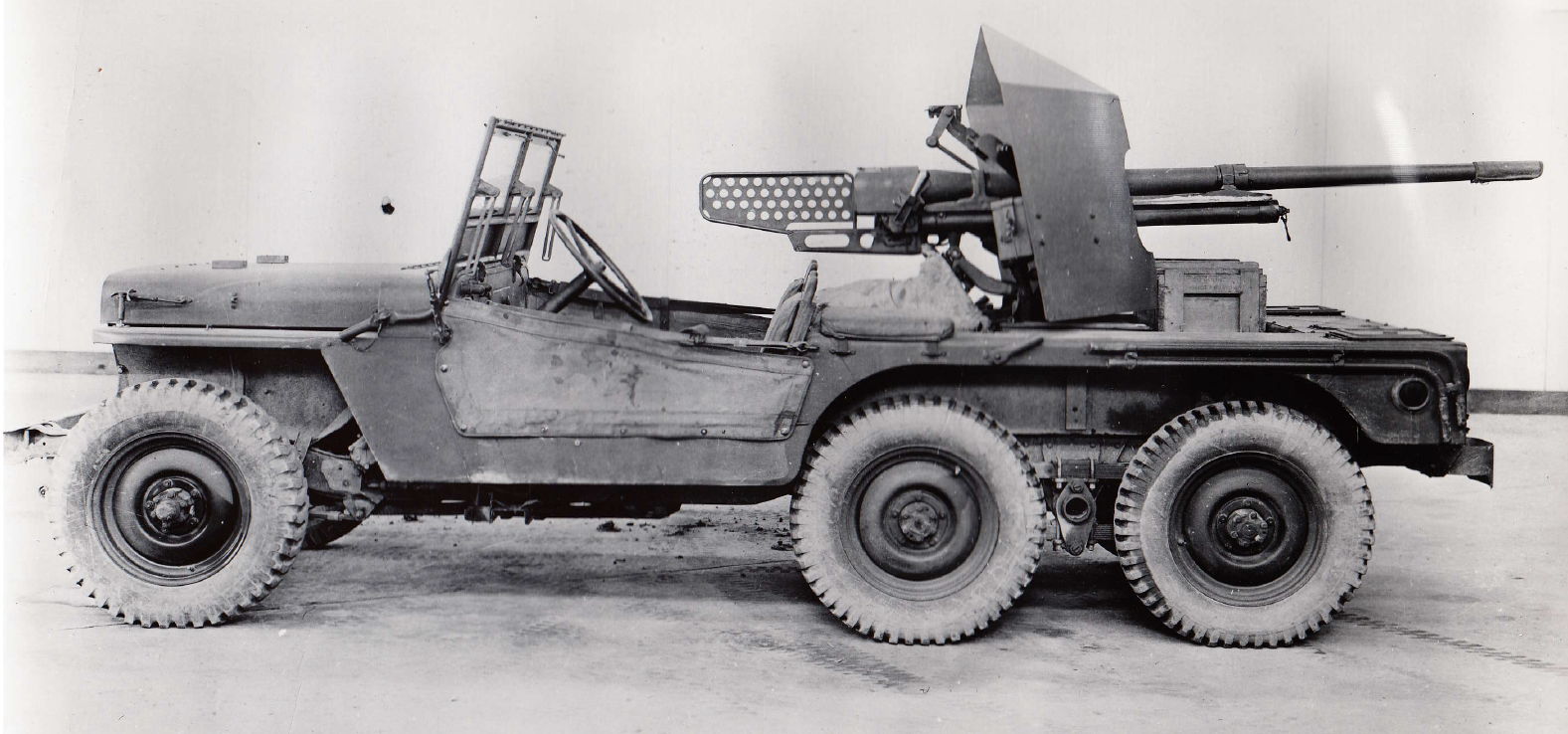
In the end, of course, the 37mm GMC T21 based on the tougher Dodge chassis was selected for the role, entering service as the 37mm GMC M6. Only to be promptly discarded as useless as the armor and armament of tanks started racing upwards.
No indication is found in the archives as to how much approval LTC Negrotto's proposal received.
For discussion on the merits of this proposal, click on Bob.
As ever, my Facebook page remains here, my Youtube channel here, and Twitch stream (Every Tuesday, and occasional evenings) is here.
